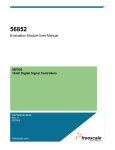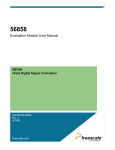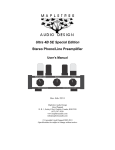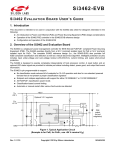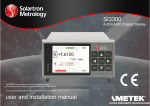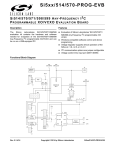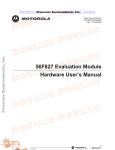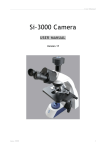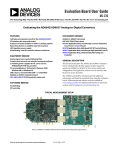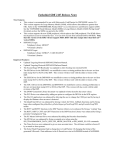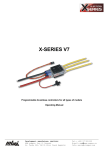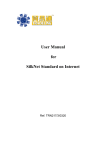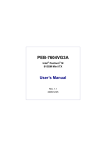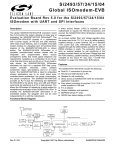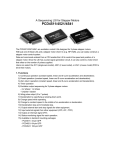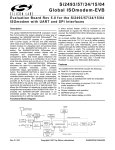Download Telecommunications Daughter Card #1 User Manual
Transcript
Telecommunications Daughter Card #1 User Manual 56F800 16-bit Digital Signal Controllers TDC1UM Rev. 2 08/2005 freescale.com TABLE OF CONTENTS Preface Chapter 1 Introduction 1.1 1.2 1.3 TDC1 Architecture . . . . . . . . . . . . . . . . . . . . . . . . . . . . . . . . . . . . . . . . . . 1-1 TDC1 Configuration Jumpers . . . . . . . . . . . . . . . . . . . . . . . . . . . . . . . . . . 1-3 TDC1 Connections . . . . . . . . . . . . . . . . . . . . . . . . . . . . . . . . . . . . . . . . . . 1-4 Chapter 2 Technical Summary 2.1 2.1.1 2.1.2 2.2 2.3 2.4 2.5 2.6 2.6.1 2.6.2 2.7 2.8 Audio Codec . . . . . . . . . . . . . . . . . . . . . . . . . . . . . . . . . . . . . . . . . . . . . . . 2-3 Codec Digital Data Path . . . . . . . . . . . . . . . . . . . . . . . . . . . . . . . . . . . 2-3 Codec Analog Data Path . . . . . . . . . . . . . . . . . . . . . . . . . . . . . . . . . . . 2-4 PSTN DAA . . . . . . . . . . . . . . . . . . . . . . . . . . . . . . . . . . . . . . . . . . . . . . . . 2-6 Clock Source . . . . . . . . . . . . . . . . . . . . . . . . . . . . . . . . . . . . . . . . . . . . . . 2-6 Keypad . . . . . . . . . . . . . . . . . . . . . . . . . . . . . . . . . . . . . . . . . . . . . . . . . . . 2-6 LCD . . . . . . . . . . . . . . . . . . . . . . . . . . . . . . . . . . . . . . . . . . . . . . . . . . . . . 2-8 Daughter Card Connectors. . . . . . . . . . . . . . . . . . . . . . . . . . . . . . . . . . . . 2-9 Memory Daughter Card Connector . . . . . . . . . . . . . . . . . . . . . . . . . . . 2-9 Peripheral Daughter Card Connector . . . . . . . . . . . . . . . . . . . . . . . . 2-11 Power Supply . . . . . . . . . . . . . . . . . . . . . . . . . . . . . . . . . . . . . . . . . . . . . 2-12 Test Points . . . . . . . . . . . . . . . . . . . . . . . . . . . . . . . . . . . . . . . . . . . . . . . 2-13 Appendix A TDC1 Schematics Appendix B TDC1 Bill of Material Appendix C Keypad & LCD CPLD VHDL Code Appendix D Keypad & LCD CPLD Schematic Table of Contents, Rev. 2 Freescale Semiconductor i TDC1 User Manual, Rev. 2 ii Freescale Semiconductor LIST OF FIGURES 1-1 Block Diagram of the TDC1. . . . . . . . . . . . . . . . . . . . . . . . . . . . . . . . . . . . . . 1-2 1-2 TDC1 Jumper Reference. . . . . . . . . . . . . . . . . . . . . . . . . . . . . . . . . . . . . . . .1-3 1-3 Connecting the TDC1 to an EVM . . . . . . . . . . . . . . . . . . . . . . . . . . . . . . . . . 1-4 2-1 Block Diagram of Audio Codec Digital Interface . . . . . . . . . . . . . . . . . . . . . . 2-3 2-2 Block Diagram of Microphone Input . . . . . . . . . . . . . . . . . . . . . . . . . . . . . . . 2-4 2-3 Block Diagram of Speaker Output . . . . . . . . . . . . . . . . . . . . . . . . . . . . . . . . . 2-5 2-4 Block Diagram of Line-Level Interface. . . . . . . . . . . . . . . . . . . . . . . . . . . . . . 2-5 2-5 DAA #1 Block Diagram . . . . . . . . . . . . . . . . . . . . . . . . . . . . . . . . . . . . . . . . . 2-6 2-6 Keypad Interface Block Diagram . . . . . . . . . . . . . . . . . . . . . . . . . . . . . . . . . .2-7 2-7 LCD Interface Block Diagram . . . . . . . . . . . . . . . . . . . . . . . . . . . . . . . . . . . . 2-8 2-8 Power Supply Block Diagram . . . . . . . . . . . . . . . . . . . . . . . . . . . . . . . . . . . 2-12 List of Figures, Rev. 2 Freescale Semiconductor iii TDC1 User Manual, Rev. 2 iv Freescale Semiconductor LIST OF TABLES 1-1 TDC1 Default Jumper Options . . . . . . . . . . . . . . . . . . . . . . . . . . . . . . . . . 1-4 2-1 SSI/ESSI Port Selector Description . . . . . . . . . . . . . . . . . . . . . . . . . . . . . 2-4 2-2 Keypad Row/Column Data Register. . . . . . . . . . . . . . . . . . . . . . . . . . . . . 2-7 2-3 LCD Data Register . . . . . . . . . . . . . . . . . . . . . . . . . . . . . . . . . . . . . . . . . . 2-8 2-4 LCD Control Register . . . . . . . . . . . . . . . . . . . . . . . . . . . . . . . . . . . . . . . .2-9 2-5 External Memory Daughter Card Connector Description . . . . . . . . . . . . . 2-9 2-6 Peripheral Daughter Card Connector Description . . . . . . . . . . . . . . . . . 2-11 List of Tables, Rev. 2 Freescale Semiconductor v TDC1 User Manual, Rev. 2 vi Freescale Semiconductor Preface This reference manual describes in detail the hardware on the Telecommunication Daughter Card #1 (TDC1). Audience This document is intended for application developers who are creating software for devices using the Freescale TDC1 with a 56F826EVM, 56F827EVM, 56852EVM or 56858EVM. Organization This manual is organized into two chapters and two appendixes. • Chapter 1, Introduction provides an overview of the TDC1 and its features. • Chapter 2, Technical Summary describes in detail the TDC1 hardware. • Appendix A, TDC1 Schematics contains the schematics of the TDC1. • Appendix B, TDC1 Bill of Material provides a list of the materials used on the TDC1 board. • Appendix C, Keypad & LCD CPLD VHDL Code contains source code for keypad and LCD. • Appendix D, Keypad & LCD CPLD Schematic includes a schematic of the keypad and LCD. Suggested Reading More documentation on the 56F826EVM, 56F827EVM, 56852EVM and 56858EVM may be found at URL: www.freescale.com Preface, Rev. 2 Freescale Semiconductor vii Notation Conventions This manual uses the following notational conventions: Term or Value Symbol Examples Active High Signals (Logic One) No special symbol attached to the signal name A0 CLKO Active Low Signals (Logic Zero) Noted with an overbar in text and in most figures WE OE Hexadecimal Values Begin with a “$” symbol $0FF0 $80 Decimal Values No special symbol attached to the number Binary Values Begin with the letter “b” attached to the number b1010 b0011 Numbers Considered positive unless specifically noted as a negative value 5 -10 Blue Text Linkable on-line Bold Reference sources, paths, emphasis Exceptions In schematic drawings, Active Low Signals may be noted by a backslash: /WE 10 34 Voltage is often shown as positive: +3.3V ...refer to Chapter 7, License ...see: www.freescale.com TDC1 User Manual, Rev. 2 viii Freescale Semiconductor Definitions, Acronyms, and Abbreviations Definitions, acronyms and abbreviations for terms used in this document are defined below for reference. AFE Analog Front End; an interface used to refer to the high voltage or PSTN side of a DAA BOM Bill of Material; list of parts used on the TDC1. Codec COder/DECoder; a part used to convert analog signals to digital (coder) and digital signals to analog (decoder) CPLD Complex Programmable Logic Device DAA Data Access Arrangement; interface between telephone line and codec DSC Digital Signal Controller ESSI Enhanced Synchronous Serial Interface port on Freescale’s family of controllers EVM Evaluation Module; a hardware platform which allows a customer to evaluate the silicon and develop his application FCC Federal Communications Commission GPIO General Purpose Input and Output port on Freescale’s family of controllers; does not share pin functionality with any other peripheral on the chip and can only be set as an input, output or level-sensitive interrupt input IC Integrated Circuit JTAG Joint Test Action Group; a bus protocol/interface used for test and debug LED Light Emitting Diode MPIO Multi Purpose Input and Output port on Freescale’s family of controllers; shares package pins with other peripherals on the chip and can function as a GPIO PCB Printed Circuit Board PSTN Public Service Telephone Network SSI Synchronous Serial Interface port on Freescale’s family of controllers Preface, Rev. 2 Freescale Semiconductor ix References The following sources were referenced to produce this manual: [1] 56F826 Evaluation Module User Manual, DSP56826EVMUM [2] 56F827 Evaluation ModuleUser Manual, DSP56827EVMUM [3] 56852 Evaluation Module User Manual, DSP56852EVMUM [4] 56858 Evaluation Module User Manual, DSP56858EVMUM TDC1 User Manual, Rev. 2 x Freescale Semiconductor Chapter 1 Introduction The TDC1, in combination with the 56F826EVM, 56F827EVM, 56852EVM or 56858EVM, can be used to demonstrate the abilities of the 56F826, 56F827, 56852 or 56858 processor in PSTN applications and provide a hardware tool allowing the development of applications that use these processors. The TDC1 is a daughter card that includes two global solid state DAA interfaces, a voice codec, 5x5 push-button keypad, a 20x4 LCD display and a set of daughter card expansion connectors. The daughter card expansion connectors allow the daughter card to communicate with the attached EVM. The TDC1, along with the attached EVM, is designed for the following purposes: • Serves as a platform for real-time software development. The TDC1 daughter card and EVM tool suite enable the user to develop and simulate routines, download the software to on-chip or on-board RAM, run it, and debug it using a debugger via the JTAG/OnCE/Enhanced OnCE (EOnCE) port or the on-board Parallel Host/Target Interface. The breakpoint features of the OnCE/EOnCE port enable the user to easily specify complex break conditions and to execute user-developed software at full speed until the break conditions are satisfied. The ability to examine and modify all user-accessible registers, memory and peripherals through the OnCE/EOnCE port greatly facilitates the task of the developer. • Serving as a platform for hardware development. The hardware platform enables the user to connect external hardware peripherals. The on-board peripherals can be disabled, providing the user with the ability to reassign any and all of the controller's peripherals. The OnCE/EOnCE port's unobtrusive design means that all memory on the board and on the chip is available to the user. Introduction, Rev. 2 Freescale Semiconductor 1-1 1.1 TDC1 Architecture The TDC1 facilitates the development of various voice and data telephony applications. The TDC1 block diagram, in Figure 1-1, shows the major blocks of this daughter card. High Voltage PSTN SSI/ESSI GPIO/MPIO DAA Codec #1 DAA Interface #1 RJ11 #1 GPIO/MPIO DAA Codec #2 DAA Interface #2 RJ11 #2 GPIO/MPIO Telephony Codec Microphone In Speaker Out Daughter Card Peripheral Connector Memory Bus Memory Mapped Registers 20 x 4 LCD 5x5 Keypad Daughter Card Memory Connector Figure 1-1. Block Diagram of the TDC1 The main features of the TDC1 daughter card include the following: • Dual PSTN Solid State DAA Interface — Two separate and unique telephone interfaces — PSTN High Voltage Isolation — Ring Detection — ON-Hook/OFF-Hook Support — Caller ID Support — Communicates with the controller over SSI/ESSI bus TDC1 User Manual, Rev. 2 1-2 Freescale Semiconductor TDC1 Architecture • Voice Codec — Microphone Input — Microphone Bias Option — Dual channel Speaker Output — Line Level Input/Output — Communicates with the controller over SSI/ESSI bus • 5 row by 5 column push-button (keypad) matrix • 20 character by 4 line LCD display • Daughter Card Peripheral Expansion Interface connector — SSI/ESSI signals — GPIO/MPIO signals — +3.3V and +5.0V Power (on 56852EVM and 56858EVM) — Ground • Daughter Card Memory Expansion Interface connector — External Data Bus — External Address Bus — External Data/Address Bus control signals — +3.3V and +5.0V Power (on 56852EVM and 56858EVM) — Ground • +5.0V Power Terminal block (Optional +5.0V power source) Introduction, Rev. 2 Freescale Semiconductor 1-3 1.2 TDC1 Configuration Jumpers Six jumper groups, (JG1-JG6), shown in Figure 1-2, are used to configure various features on the TDC1. Table 1-1 describes the default jumper group settings. 1 3 JG2 JG3 JG1 1 TB1 +5V Mic IN J2 J1 JG5 Speaker OUT GND 3 JG2 J3 JG6 LCD J4 PSTN #1 JG6 JG3 16 JG1 18 JG4 JG5 J104 PSTN #2 JG4 Figure 1-2. TDC1 Jumper Reference TDC1 User Manual, Rev. 2 1-4 Freescale Semiconductor TDC1 Configuration Jumpers Table 1-1. TDC1 Default Jumper Options Jumper Group Note: Comment Jumpers Connections JG1 Selects the use of SSI1/ESSI1 Port signals for the Codecs 2–3, 5–6, 8–9, 11–12, 14–15, 17–18 JG2 Use of the on-board microphone bias voltage 1–2 JG3 Uses Frame Sync from DAA #2 Codec for Voice Codec 2–3 JG4 Enables DAA #2 Codec 1–2 JG5 Uses the +5.0V power from the EVM 1–2 JG6 Uses CS3 to enable the CPLD’s Keypad and LCD registers 1–2 When using the TDC1 board with a 56F826EVM, 56F827EVM, 56852EVM or 56858EVM board, with Processor Expert, the jumper configurations for the TDC1 board must be changed as follows: • JG1 must have the jumpers configured to use SC0 instead of SC1. The jumper settings need to be changed to 1-2, 4-5, 7-8, 10-11, 13-14, 16-17. • JG3 must be configured for Codec Frame Sync 1 instead of Codec Frame Sync 2. The jumper setting need to be changed to 1-2. • JG4 must changed to disable DAA 2. The jumper on JG4 must be removed. This is due to a limitation in the Processor Expert only supporting the first channel of the two channel TDC1 board. The TDC1 attaches to a 56F826EVM, 56F827EVM, 56852EVM or 56858EVM via the two Daughter Card connectors located on the bottom of the TDC1 handle. An interconnection diagram is shown in Figure 1-3 for connecting the TDC1 onto the top of an EVM board. Note: If using a 56852EVM or 56858EVM board, the +5.0V used to power the LCD module can be supplied by the EVM by installing jumper JG5. If a 56F826EVM or 56F827EVM board is being used, the +5.0V for the LCD module should be supplied to the TDC1 Daughter Card at TB1 by an external +5.0V DC power supply. Introduction, Rev. 2 Freescale Semiconductor 1-5 TDC1 Board EVM Board Daughter Card Connectors Figure 1-3. Connecting the TDC1 to an EVM Perform the following steps to connect the TDC1 to an EVM: 1. Align the two daughter card connectors of the bottom on the TDC1 board with the two daughter card connectors on the top of the EVM board 2. Firmly press the two boards together at these connectors to attach 3. Following the power connection instructions in User’s Manual for the EVM you’re implementing, connect power to the EVM 4. If +5.0V power is to be provided for the LCD from an external +5.0V power supply: — Remove the jumper at JG5 — Attach the +5.0V power to the TDC1 at TB1 Note: Failure to remove JG5 could potentially damage the EVM 5. Apply power to the EVM. — The TDC1’s green Power-On LED, LED1, will illuminate when +3.3V power is present TDC1 User Manual, Rev. 2 1-6 Freescale Semiconductor Chapter 2 Technical Summary The TDC1, in combination with the 56F826EVM, 56F827EVM, 56852EVM or 56858EVM, can be used to demonstrate the abilities of the 56F826, 56F827, 56852 or 56858 processor in PSTN applications and provide a hardware tool allowing the development of applications that use these processors. The TDC1 is a daughter card that includes two global solid state DAA interfaces, a telecommunications codec, 5x5 push-button keypad, a 20x4 LCD display and a set of daughter card expansion connectors. The daughter card expansion connectors allow the daughter card to communicate with the attached EVM. The main features of the TDC1 Daughter Card, with board and schematic reference designators, include: • PSTN Solid State DAA Interface #1 (U2 & U3) — RJ11 Telephone interfaces (J4) — PSTN High Voltage Isolation Interface (U3) — Ring Detection (U2) — ON-Hook/OFF-Hook Support (U2) — Caller ID Support (U2) — Communicates with the controller over SSI/ESSI bus (U2) • PSTN Solid State DAA Interface #2 (U102 & U103) — RJ11 Telephone interfaces (J104) — PSTN High Voltage Isolation Interface (U103) — Ring Detection (U102) — ON-Hook/OFF-Hook Support (U102) — Caller ID Support (U102) — Communicates with the controller over SSI/ESSI bus (U102) Technical Summary, Rev. 2 Freescale Semiconductor 2-1 • Voice Codec (U1) — Microphone Input (J1) — Microphone Bias Option (JG2) — Dual-channel Speaker Output (J2) — Line-Level Input/Output (J3) — Communicates with the controller over SSI/ESSI bus (U1) • 5 Row by 5 Column push-button (keypad) matrix (S1-S25) • 20 character by 4 line LCD display (LCD1) • LCD contrast adjustment (R49) • Keypad & LCD memory bus register logic (U5) • Optional CS3 enable (JG6) • Optional +5.0V supplied from 56852EVM or 56858EVM board (JG5) • SSI/ESSI Port 0 or Port 1 source selector (JG1) • DAA #2 selector (JG4) • Audio Codec Frame Sync source selector (JG3) • Daughter Card Peripheral Expansion Interface connector (P2) — SSI/ESSI signals — GPIO/MPIO signals — +3.3V and +5.0V Power (on 56852EVM and 56858EVM) — Ground • Daughter Card Memory Expansion Interface connector (P1) — External Data Bus — External Address Bus — External Data/Address Bus control signals — +3.3V and +5.0V Power (on 56852EVM and 56858EVM) — Ground • +5.0V Power Terminal block. (Optional +5.0V power source) (TB1) • +3.3V Power OK LED (LED1) TDC1 User Manual, Rev. 2 2-2 Freescale Semiconductor Audio Codec 2.1 Audio Codec The TDC1 uses a Silicon Labs Si3000, designated as U1 on the board and in the schematics. This Codec provides the Microphone Input analog to digital and digital to analog Speaker Output interface for the EVM’s controller. 2.1.1 Codec Digital Data Path The Audio Codec is connected to the SSI/ESSI signals from the Peripheral Daughter Card connector through the SSI/ESSI Port selector, JG1. SSI0/ESSI0 and SSI1/ESSI1 Port signals are present on JG1, allowing the easy use of either port. To select SSI0/ESSI0 port, jumper the left pins of the header to the header’s center pins. To select SSI1/ESSI1 port, jumper the right pins of the header to the header’s center pins; reference Figure 2-1 and Table 2-1. Si3000 P2 JG1 STD SSI0/ESSI0 SDI SRD SDO SCK SSI1/ESSI1 MCLK SCx1 Peripheral Daughter Card RESET JG3 FSDAA1 1 FSDAA2 3 FSYNC Figure 2-1. Block Diagram of Audio Codec Digital Interface Technical Summary, Rev. 2 Freescale Semiconductor 2-3 Table 2-1. SSI/ESSI Port Selector Description JG1 Pin # Signal Pin # Signal Pin # Signal 1 STD0 2 SDI 3 STD1 4 SRD0 5 SDO 6 SRD1 7 SCK0 8 SCLK 9 SCK1 10 SC00 11 DAARST 12 SC10 13 SC01 14 RST 15 SC11 16 SC02 17 MFSYNC 18 SC12 . 2.1.2 Codec Analog Data Path The CODEC provides microphone input, speaker output, line-level input and line-level output analog paths. 2.1.2.1 Microphone Input The microphone input is via a 1/8” stereo phone jack (J1); reference Figure 2-2. The tip connection on the jack provides the mono microphone input signal. The ring connection on the jack provides an optional microphone bias voltage for use with Electret condenser microphones. The barrel connection on the jack provides the microphone ground reference signal. MIC_BIAS Microphone Bias Microphone Input MIC_IN A Figure 2-2. Block Diagram of Microphone Input TDC1 User Manual, Rev. 2 2-4 Freescale Semiconductor Audio Codec 2.1.2.2 Speaker Output The speaker output is provided via another 1/8” stereo phone jack (J2); reference Figure 2-3. The tip connection on the jack provides the Left speaker channel output signal. The ring connection on the jack provides the Right speaker channel output signal. The barrel connection on the jack provides the speaker’s ground reference signal. SPKR_R Speaker Output SPKR_L A Figure 2-3. Block Diagram of Speaker Output 2.1.2.3 Line-Level Analog The line-level input and output signals are provided via a 3-pin header (J3); reference Figure 2-4. This header allows easy connection to the line-level output, on pin-1, line-level input, on pin-2, and ground reference signals, on pin-3. Line_Out 1 Line_In 2 Line Level Input/Output 3 A Figure 2-4. Block Diagram of Line-Level Interface Technical Summary, Rev. 2 Freescale Semiconductor 2-5 2.2 PSTN DAA Two PSTN DAAs are used on the TDC1 to provide the high-voltage telephone line isolation, proper AC and DC telephone line load terminations, On/Off Hook control, Ring Detection and Caller ID support for two separate PSTN lines. Each PSTN DAA, Silicon Labs Si3044 chipset, on the TDC1 supports a single telephone line in various data modem and fax standards, i.e., V.22bis, V.8bis, V.32bis, V.42bis, V.34bis, V.17, V.21, V.27, V.29 and V.90. The chipset consists of an Analog Front End (AFE) part, Silicon Labs Si3015, which interfaces to the high voltage PSTN and a Digital Interface part, Silicon Labs Si3021, which interfaces with the controller and Codec. See Figure 2-5 for a block diagram of the DAA #0 DAA. The Si3015 and Si3021 parts are capacitively coupled, providing over 3000 volts of isolation between the PSTN and the on-board digital electronics. U2 U3 J4 TIP C1 AFE DAA CODEC RING RJ11 Peripheral Daughter Card Figure 2-5. DAA #1 Block Diagram 2.3 Clock Source The Master Clock Source for the TDC1 is a 4.000MHz oscillator. This Master Clock Source is used to drive the Master DAA Codec. Using its on-chip PLL, it can create the required bit rates for various telecommunication protocols. TDC1 User Manual, Rev. 2 2-6 Freescale Semiconductor Keypad 2.4 Keypad The TDC1 provides a 5 x 5 push-button keypad (S1-S25). These push-buttons are unlabeled and arranged in a 5 row by 5 column matrix. This keypad matrix is connected to the controller as memory-mapped GPIO via a CPLD (U5). This CPLD connects to the controller’s address and memory bus providing I/O for row-strobing and column-sensing keypad detection to the keypad via a memory-mapped register; reference Figure 2-6 and Table 2-2. The CPLD is configured to use CS3 as the chip select for the memory-mapped registers. The Keypad will be assigned to the first address location in this CS3 enabled memory map. CS3 can be disabled from the TDC1 to allow other uses for this chip select by removing the jumper on JG6. This location contains the 5-bit Row write register and the 5-bit Column read register. This allows the code developer to strobe the rows and sense the columns. U5 J1 Row0-4 Address Keypad/LCD CPLD Data 5x5 Keypad Matrix Control CS3 CS Column0-4 JG6 Daughter Card Memory Connector Figure 2-6. Keypad Interface Block Diagram Table 2-2. Keypad Row/Column Data Register CS3 Base Address + 0 Bit # Write Function Read Function 0 Row 0 Strobe Column 0 State 1 Row 1 Strobe Column 1 State 2 Row 2 Strobe Column 2 State 3 Row 3 Strobe Column 3 State 4 Row 4 Strobe Column 4 State Technical Summary, Rev. 2 Freescale Semiconductor 2-7 2.5 LCD The TDC1 provides a 20 character by 4 line LCD display. This display has a parallel interface, allowing the LCD to be connected to a memory-mapped GPIO CPLD. This CPLD is connected to the controller’s memory bus providing I/O to the LCD via a memory-mapped register; reference Figure 2-7. The CPLD is configured to use CS3 as the chip select for the memory-mapped registers. CS3 can be disabled from the TDC1 to allow other uses for this chip select by removing the jumper on JG6. The LCD is assigned to the second and third address locations in the CS3-enabled memory map. The first LCD address location contains the 8-bit read/write LCD Data register; reference Table 2-3. The second LCD address location contains the 3-bit read/write LCD Control register; reference Table 2-4. U5 J1 Address Data0-7 Keypad/LCD CPLD Data RS, RW, E 20 x 4 LCD Control CS3 CS JG6 Daughter Card Memory Connector Figure 2-7. LCD Interface Block Diagram TDC1 User Manual, Rev. 2 2-8 Freescale Semiconductor LCD Table 2-3. LCD Data Register CS3 Base Address + 1 Bit # LCD Function 0 Data bit 0 to/from LCD 1 Data bit 1 to/from LCD 2 Data bit 2 to/from LCD 3 Data bit 3 to/from LCD 4 Data bit 4 to/from LCD 5 Data bit 5 to/from LCD 6 Data bit 6 to/from LCD 7 Data bit 7 to/from LCD Table 2-4. LCD Control Register CS3 Base Address + 2 Bit # Symbol LCD Function 0 RS 1 = Data Input to LCD; 0 = Instruction Code Input to LCD 1 R/W 1 = Read Data from LCD; 0 = Write Data to LCD 2 E Normally 1; Transition from 1 => 0 Enables Transfer Technical Summary, Rev. 2 Freescale Semiconductor 2-9 2.6 Daughter Card Connectors Two Daughter Card connectors are provided on the TDC1 Daughter Card. One Daughter Card connector provides access to the controller’s peripherals. The other Daughter Card connector provides access to the controller’s external memory bus. 2.6.1 Memory Daughter Card Connector An External Memory Daughter Card connector provides all of the controller’s address, data and external memory interface control signals, along with power and ground. Only the controller signals used by the TDC1 are present on the connector; reference Table 2-5. Table 2-5. External Memory Daughter Card Connector Description P1 Pin # Signal Pin # Signal 1 NC 2 NC 3 NC 4 NC 5 NC 6 NC 7 NC 8 NC 9 NC 10 NC 11 WR 12 NC 13 D0 14 NC 15 D1 16 NC 17 D2 18 NC 19 GND 20 GND 21 D3 22 NC 23 D4 24 NC 25 D5 26 NC 27 D6 28 NC 29 NC 30 NC 31 D7 32 NC TDC1 User Manual, Rev. 2 2-10 Freescale Semiconductor Daughter Card Connectors Table 2-5. External Memory Daughter Card Connector Description (Continued) P1 Pin # Signal Pin # Signal 33 NC 34 NC 35 A0 36 RD 37 A1 38 NC 39 NC 40 GND 41 NC 42 NC 43 NC 44 NC 45 CS3 46 NC 47 +3.3V 48 +3.3V 49 GND 50 GND 51 +5.0V 2.6.2 Peripheral Daughter Card Connector The peripheral daughter card connector provides the SSI/ESSI and GPIO signals from the controller, along with power and ground for the TDC1. Only the signals used on the TDC1 are used on this connector; reference Table 2-6. Table 2-6. Peripheral Daughter Card Connector Description P2 Pin # Signal Pin # Signal 1 NC 2 NC 3 NC 4 NC 5 NC 6 NC 7 NC 8 NC 9 NC 10 NC 11 NC 12 NC 13 GND 14 GND Technical Summary, Rev. 2 Freescale Semiconductor 2-11 Table 2-6. Peripheral Daughter Card Connector Description (Continued) P2 Pin # Signal Pin # Signal 15 SRD0 16 SRD1 17 SC01 18 SC11 19 NC 20 SCK1 21 GND 22 GND 23 NC 24 SC10 25 NC 26 SC12 27 GND 28 GND 29 NC 30 STD1 31 SC00 32 NC 33 SC02 34 NC 35 NC 36 NC 37 GND 38 GND 39 STD0 40 NC 41 SCK0 42 NC 43 NC 44 NC 45 NC 46 NC 47 +3.3V 48 +3.3V 49 GND 50 GND 51 +5.0V TDC1 User Manual, Rev. 2 2-12 Freescale Semiconductor Power Supply 2.7 Power Supply The main power, +3.3VDC, for the TDC1 is provided through the Daughter card connectors; reference Figure 2-8. This power will be used by most of the components on the TDC1 board. The secondary power, +5.0V DC, for use by the LCD is provided through the Daughter Card connectors and, optionally, via a terminal block on the TDC1 board. The analog voltages required by the analog logic on the TDC1 board are to be created from the +3.3V digital supply. A Power-On LED illuminates when +3.3V power is provided on the TDC1 board. Technical Summary, Rev. 2 Freescale Semiconductor 2-13 Daughter Card Connectors +5.0VDC +5.0VDC Power Condition +3.3V DC Analog +3.3V DC Power Selector 1 2 +3.3V DC +5.0V DC +5.0VDC 1 GND 2 Terminal Block Codec Codec CPLD LCD Figure 2-8. Power Supply Block Diagram 2.8 Test Points Test points are provided on the TDC1 board to allow voltage and signal reference measurements for the following test points: • • • • • • • • • • • Codec AOUT DAA #1 AOUT DAA #1 RGDT DAA #1 OFHK, DAA #1 +3.3VA DAA #2 AOUT DAA #2 RGDT DAA #2 OFHK +3.3V +5.0V GND TDC1 User Manual, Rev. 2 2-14 Freescale Semiconductor Appendix A TDC1 Schematics Appendix A, Rev. 2 Freescale Semiconductor A-1 TDC1 User Manual, Rev. 2 A-2 Freescale Semiconductor 1 2 3 4 A A Daughter Card Memory Connector A Size Title LCD 5 x 5 Keypad Matrix TDC1.DSN C Date: Monday, May 20, 2002 Document Number D D PSTN LINE 2 PSTN LINE 1 E E of 9 1.2 Rev. FAX: (480) 413-2510 Sheet 1 (480) 413-5090 2100 East Elliot Road Tempe, Arizona 85284 DSP Standard Products Division RJ11 RJ11 Designer: D S P D D e s i g n DAA HIGH-SIDE DAA HIGH-SIDE TDC1 BLOCK DIAGRAM OVERVIEW Memory Mapped I/O Registers CODEC FS DAA LOW-SIDE FS DAA LOW-SIDE C Figure A-1. TDC1 BLOCK DIAGRAM OVERVIEW B Control Data Address Daughter Card Peripheral Connector SSI/ISSI/ESSI B 1 2 3 4 Appendix A, Rev. 2 Freescale Semiconductor A-3 1 2 3 4 5.50" 2.5" J4 A TB1 4" HIGH VOLTAGE AREA HIGH VOLTAGE AREA J104 A U103 U3 J1 B U102 U2 U1 J2 B 8" TDC1.DSN C Date: Monday, May 20, 2002 Document Number TDC1 PART PLACEMENT P2 D 4.15" D U5 E 1.5" E of 9 1.2 Rev. FAX: (480) 413-2510 Sheet 2 (480) 413-5090 2100 East Elliot Road Tempe, Arizona 85284 DSP Standard Products Division P1 & P2 on bottom of board. Designer: D S P D D e s i g n NOTE: S/N TELECOMMUNICATIONS DAUGHTER CARD COPYRIGHT @ 2002 MOTOROLA, INC Figure A-2. TDC1 PART PLACEMENT A Size Title S25 S21 S5 S15 20 X 4 LCD S11 S1 P3 3.875" C P1 1 2 3 4 TDC1 User Manual, Rev. 2 1 2 3 4 R4 47K 12 13 14 JG3 OPTIONS +3.3V +3.3VA1 4 5 7 9 6 VD VA GND SDI SDO MCLK Si3000-KS RESET FSYNC U1 HDST SPKRL SPKRR LINE0 LINE1 MIC MBIAS SCLK A A Size 1 T P 10 TDC1.DSN C Date: Monday, May 20, 2002 Document Number C36 10uF 30 R20 0.1uF C34 2.2K D 1 2 3 J3 3 11 10 2 1 3 11 10 2 1 J2 E J1 E of 9 1.2 Rev. FAX: (480) 413-2510 Sheet 3 (480) 413-5090 2100 East Elliot Road Tempe, Arizona 85284 DSP Standard Products Division 30 R21 C38 0.1uF C37 10uF C33 0.1uF R14 Designer: D S P D D e s i g n LINE_IN D C35 10uF LINE_OUT SPKR_L MIC_IN 2 JG2 1 SPKR_R MIC_BIAS CODEC AND AUDIO CONNECTIONS AOUT SPKR_L SPKR_R 16 1 3 LINE_OUT LINE_IN MIC_IN MIC_BIAS 15 11 2 10 8 47K R1 +3.3V C Figure A-3. CODEC AND AUDIO CONNECTIONS B CODEC DISABLED N/C Title CODEC IN SSI CHAIN AFTER DAA #2 2-3 1-2 SDI SDO SCLK 2 CODEC IN SSI CHAIN AFTER DAA #1 3 FSD2 /RST 1 JG3 FSD1 B + + A + A-4 Freescale Semiconductor 1 2 3 4 Appendix A, Rev. 2 1 2 3 15 16 18 SC11 SC02 SC12 17 14 11 8 5 2 A SSI Signal Selector 13 SC01 10 SC00 12 9 SCK1 SC10 7 SCK0 4 SRD0 6 3 STD1 SRD1 1 STD0 JG1 +3.3V 2 1 4 B U4 OUT 4.000MHz GND EN VCC A Size Title 3 /DAARST SCLK C41 0.1uF VA C42 0.1uF GND M0 M1 VD 12 14 10 4 13 9 11 16 7 M0 M1 10 TDC1.DSN C Date: Monday, May 20, 2002 Document Number 1 T P 13 DAACOUPLING1 1 TP2 1 TP1 D 1K R23 1K R22 10K R38 10K R37 +3.3V Sheet 4 E of 9 1.2 Rev. FAX: (480) 413-2510 2100 East Elliot Road Tempe, Arizona 85284 (480) 413-5090 Designer: D S P D D e s i g n D M1 M0 /OFHK /RGDT E DSP Standard Products Division +3.3VA1 MASTER MODE +3.3V +3.3VA1 C39 0.1uF AOUT /OFHK /RGDT TP7 R3 Si3021KS RGDT/FSD RESET SCLK AOUT C1A DEHK FC/RGDT TP3 15 8 3 SDO SDI FSYNC MCLK U2 D A A L O W V O LTAGE SECTION CHANNEL #1 +3.3V FSD1 6 SDI 5 2 /MFSYNC SDO 1 MCLK C Figure A-4. DAA LOW VOLTAGE SECTION CHANNEL #1 /MFSYNC /RST /DAARST SCLK SDO SDI 10K R27 +3.3V B 1 4 A 1 Freescale Semiconductor A-5 1 2 3 4 TDC1 User Manual, Rev. 2 A-6 Freescale Semiconductor 1 2 3 4 A A FSD1 2 DAA #2 ENABLE 1 JG4 B C141 0.1uF C142 0.1uF 12 14 10 4 13 9 11 16 7 C139 0.1uF M0 M1 AOUT /OFHK /RGDT +3.3VA2 SLAVE MODE +3.3V +3.3VA2 1 T P 14 DAACOUPLING2 1 TP9 1 TP8 TDC1.DSN C Date: Monday, May 20, 2002 Document Number D D SDO M0 M1 /FSYNC /OFHK /RGDT 47K R144 1K R122 1K R123 10K R141 10K R138 10K R137 +3.3V E E of 9 1.2 Rev. FAX: (480) 413-2510 Sheet 5 (480) 413-5090 2100 East Elliot Road Tempe, Arizona 85284 DSP Standard Products Division Designer: D S P D D e s i g n D A A L O W V O LTAGE SECTION CHANNEL #2 10 R103 GND M0 M1 VD VA AOUT C1A DEHK FC/RGDT Si3021KS RGDT/FSD RESET SCLK SDO SDI FSYNC Size A U102 MCLK Title 15 8 3 5 6 2 1 C Figure A-5. DAA LOW VOLTAGE SECTION CHANNEL #2 +3.3V FSD2 /DAARST SDO SDI /FSYNC SCLK B 1 2 3 4 Freescale Semiconductor 1 2 3 4 D A A C O U P L I N G1 R7 4.87K 1% A 1 5 0pF C1 R8 4.87K 1% A R15 4.87K 1% U3 B C E B E C14 0.68uF R11 10K 1% R12 78.7 1% R13 215 1% C8 C7 Anode R18 2.2K 15K R9 15K R10 C22 1800pF Cathode Common CMPD2004S 1 8 00pF C18 0.012uF C19 0.012uF 1 8 00pF R2 402 1% 0.1uF C5 C C Q4 Z1 ZMM43 R24 150 BCP56T1 R16 4.87K 1% Q3 R19 4.87K 1% B Size Title C9 D2 D1 C4 1 5 0pF R25 10M R26 10M FB2 FB1 TDC1.DSN D Date: Monday, May 20, 2002 Document Number C31 1000pF TIP RING C32 1000pF E RJ11 6 5 4 3 2 1 J4 Designer: DSPD Design E of 9 1.2 Rev. FAX: (480) 413-2510 Sheet 6 (480) 413-5090 2100 East Elliot Road Tempe, Arizona 85284 DSP Standard Products Division SID1 P3100SB BLM31A601S C24 1000pF C25 1000pF BLM31A601S G L OBAL DAA High Voltage Section Channel #1 CMPD2004S 0.01uF C20 120K R6 MMBTA92LT1 0.022uF CMPD2004S Q2 MMBTA42LT1 MMBTA42LT1 R17 4.87K 1% R5 100K 1% Q1 D Figure A-6. GLOBAL DAA HIGH VOLTAGE SECTION CHANNEL #1 B C12 1.0uF C16 0.1uF C C6 0.1uF C 16 15 14 13 12 11 10 9 MMBTA42LT1 MMBTA92LT1 Si3015-KS TSTA/QE2 TX/FILT2 TSTB/DCT NC/FILT IGND RX C1B REXT RNG1 DCT/REXT2 RNG2 NC/REF QB NC/VREG2 QE VREG BCP56T1 1 2 3 4 5 6 7 8 C13 + 0.1uF B + Appendix A, Rev. 2 A-7 1 2 3 4 A-8 1 2 3 4 D A A C O U P L I N G2 R 1 07 4.87K 1% R 1 08 4.87K 1% A 1 5 0pF C 1 01 A R 1 15 4.87K 1% C 1 16 0.1uF B C E E C 1 14 0.68uF R 1 11 10K 1% R 1 13 215 1% R 1 12 78.7 1% C 1 05 C 1 08 C 1 07 Anode 15K R 1 09 15K R 1 10 Cathode Common R 1 18 C 2.2K C 1 22 1 8 00pF CMPD2004S 1 8 00pF C 1 18 0.012uF C 1 19 0.012uF 1 8 00pF R102 402 1% 0.1uF C Q104 Z 1 01 ZMM43 R124 150 BCP56T1 B Size Title R 1 16 4.87K 1% Q103 R 1 19 4.87K 1% C 1 09 D 1 02 C 1 04 150pF R 1 25 10M R 1 26 10M TDC1.DSN D Date: Monday, May 20, 2002 Document Number F B 102 F B 101 S I D 1 01 P3100SB E C 1 31 1 0 00pF C 1 32 1 0 00pF TIP RING RJ11 6 5 4 3 2 1 J 1 04 Designer: DSPD Design E of 9 1.2 Rev. FAX: (480) 413-2510 Sheet 7 (480) 413-5090 2100 East Elliot Road Tempe, Arizona 85284 DSP Standard Products Division BLM31A601S C 1 24 1000pF C 1 25 1000pF BLM31A601S G L OBAL DAA High Voltage Section Channel #2 CMPD2004S D 1 01 0.022uF CMPD2004S 0.01uF C 1 20 120K R 1 06 MMBTA92LT1 Q102 MMBTA42LT1 MMBTA42LT1 R 1 17 4.87K 1% R 1 05 100K 1% Q101 D Figure A-7. GLOBAL DAA HIGH VOLTAGE SECTION CHANNEL #2 B B C C 1 06 0.1uF C 16 15 14 13 12 11 10 9 MMBTA42LT1 MMBTA92LT1 Si3015-KS TSTA/QE2 TX/FILT2 TSTB/DCT NC/FILT IGND RX C1B REXT RNG1 DCT/REXT2 RNG2 NC/REF QB NC/VREG2 QE VREG C 1 12 1.0uF BCP56T1 1 2 3 4 5 6 7 8 U 1 03 C 1 13 + 0.1uF B + TDC1 User Manual, Rev. 2 Freescale Semiconductor 1 2 3 4 Appendix A, Rev. 2 Freescale Semiconductor A-9 1 2 3 4 LCD CONTRAST ADJUST 1 2 3 4 5 6 R49 10K A +5.0V 15 26 35 9 24 11 10 1 2 3 5 6 7 8 12 13 14 16 18 19 VO GND TCK TDO TDI TMS +3.3V TDI TDO TCK TMS XILINX JTAG J6 +3.3V D0 D1 D2 D3 D4 D5 D6 D7 A0 A1 /RD /WR /CS3 A U5 GND1 GND2 GND3 IO14 IO15 IO16 IO17 IO18 IO19 IO20 IO21 IO22 IO23 GSR/IO24 IO25 GTS/IO26 IO27 IO28 IO29 IO30 IO31 IO32 GCK2/IO33 GCK3/IO34 P3 1 2 3 4 5 6 7 8 9 10 11 12 13 14 15 16 LCD DD7 DD6 DD5 DD4 DD3 DD2 DD1 DD0 /E R/W RS ROW0 COL0 ROW1 COL1 ROW2 COL2 ROW3 COL3 ROW4 COL4 B 1 T P 11 1 T P 12 +5.0V 4 17 25 20 21 22 23 27 28 29 30 31 32 33 34 36 37 38 39 40 41 42 43 44 A Size Title ROW2 ROW1 ROW0 1K +3.3V TDC1.DSN C Date: Tuesday, May 21, 2002 Document Number COL4 COL3 COL2 COL1 COL2 S23 S18 S13 S8 S3 D +3.3V D COL3 S24 S19 S14 S9 S4 /CS3 R/W RS /E S25 S20 S15 S10 S5 47K R146 47K R62 47K R61 47K R60 COL4 E +3.3V E of 9 1.2 Rev. FAX: (480) 413-2510 Sheet 8 (480) 413-5090 2100 East Elliot Road Tempe, Arizona 85284 DSP Standard Products Division 1K R59 1K R58 1K R57 1K R56 Designer: D S P D D e s i g n 5 X 5 KEYPAD MATRIX AND LCD DISPLAY 47K R55 COL0 R54 47K R53 R52 ROW4 ROW3 S22 S17 S12 S7 S2 COL1 47K +3.3V COL0 S21 S16 S11 S6 47K R51 47K R50 ROW4 ROW3 ROW2 ROW1 ROW0 S1 C Figure A-8. 5 X 5 KEYPAD MATRIX AND LCD DISPLAY VO RS R/W /E DD0 DD1 DD2 DD3 DD4 DD5 DD6 DD7 GND XC9536XL-5-VQ44 VCC1 VCC2 VCC3 TDI TDO TCK TMS GCK1/IO1 IO2 IO3 IO4 IO5 IO6 IO7 IO8 IO9 IO10 IO11 IO12 IO13 B 1 2 3 4 TDC1 User Manual, Rev. 2 1 2 3 +3.3V /CS POWER GOOD LED A GND /CS GND GND GND +3.3V STD0 SCK0 SC00 SC02 SRD0 SC01 GND GND GND GND GND P2 1 3 5 7 9 11 13 15 17 19 21 23 25 27 29 31 33 35 37 39 41 43 45 47 49 51 B +5VDC INPUT + 1 2 TB1 TP4 A Size Title 1 2 +5.0VD +5.0V TDC1.DSN C Date: Monday, May 20, 2002 Document Number GND GND GND GND GND +3.3V PD0 PD3 PD5 PD1 PD4 PD2 D GND TP6 TP5 STD1 SC10 SC12 SRD1 SC11 SCK1 E E of 9 1.2 Rev. FAX: (480) 413-2510 Sheet 9 (480) 413-5090 2100 East Elliot Road Tempe, Arizona 85284 DSP Standard Products Division Designer: D S P D D e s i g n D A U G H T E R CARD EXPANSION CONNECTORS +5.0V JG5 2 4 6 8 10 12 14 16 18 20 22 24 26 28 30 32 34 36 38 40 42 44 46 48 50 Daughter Peripheral Port Connector +5.0VD +3.3V PC0 PC2 PC3 PC5 PC1 PC4 D Figure A-9. DAUGHTER CARD EXPANSION CONNECTORS LED1 GREEN LED R145 270 +3.3V /CS3 /RD C Daughter Card Connectors are located on Bottom of Board Daughter Address/Data Connector +5.0VD CS Enable 1 2 JG6 A0 A1 D7 D3 D4 D5 D6 GND 2 4 6 8 10 12 14 16 18 20 22 24 26 28 30 32 34 36 38 40 42 44 46 48 50 1 /WR D0 D1 D2 P1 1 3 5 7 9 11 13 15 17 19 21 23 25 27 29 31 33 35 37 39 41 43 45 47 49 51 B 1 4 A 1 A-10 Freescale Semiconductor 1 2 3 4 Appendix B TDC1 Bill of Material Qty. Description Ref. Designators Vendor Part #s Integrated Circuits 1 Voice Codec U1 Silicon Labs, Si3000-KS 2 DAA Codec U2, U102 Silicon Labs, Si3021-KS 2 PSTN FAE U3, U103 Silicon Labs, Si3015-KS 1 4.0000MHz Oscillator U4 Epson, SG-531P-4.000MC 1 CPLD U5 Xilinx, XC9536XL-5-VQ44 Resistors 12 47K :, 5%, 0805 R1, R4, R50 - R54, R60 - R62, R144, R146 Venkel, CR0805-10W-473JT 2 402 :, 1%, 1206 R2, R102 Venkel, CR1206-8W-4020FT 2 10 :, 5%, 0805 R3, R103 Venkel, CR0805-10W-100JT 2 100K :, 1%, 0603 R5, R105 Venkel, CR0603-16W-104FT 2 120K :, 5%, 0603 R9, R12 - R14, R48 Venkel, CR0603-16W-124JT 12 4.87K :, 1%, 1206 R7, R8, R15 - R17, R19, R107, R108, R115 - R117, R119 Venkel, CR1206-4W-4871FT 4 15K :, 5%, 0805 R9, R10, R109, R110 Venkel, CR1206-4W-4871FT 2 10K :, 1%, 0603 R11, R111 Venkel, CR0603-16W-1002FT 2 78.7 :, 1%, 0603 R12, R112 Venkel, CR0603-16W-78R7FT 2 215 :, 1%, 0603 R13, R113 Venkel, CR0603-16W-2150FT 3 2.2K :, 5%, 080 R14, R18, R118 Venkel, CR0805-10W-222JT 2 30 :, 5%, 0603 R20, R21 Venkel, CR0603-16W-300JT Appendix B, Rev. 2 Freescale Semiconductor B-1 Qty. Description Ref. Designators Vendor Part #s Resistors (Continued) 9 1K :, 5%, 0805 R22, R23, R55, R56 - R59, R122, R123 2 150 :, 5%, 0603 R24, R124 Venkel, CR0603-16W-150JT 4 10M :, 5%, 0805 R25, R26, R125, R126 Venkel, CR0805-10W-106JT 6 10K :, 5%, 0805 R27, R37, R38, R137, R138, R141 Venkel, CR0805-10W-103JT 1 270 :, 5%, 0805 R145 Venkel, CR0805-10W-271JT 1 10K : POT CT94W R49 BC, CT94W103 Venkel, CR0603-16W-2150FT Inductors 4 BLM31A601S FB1, FB2, FB101, FB102 Murata, BLM31A601S LEDs 1 Green LED LED1 Hewlett-Packard, HSMG-C650 Diodes 4 Dual Diode, SOT-23 2 Zener Diode, SOD-80 D1, D2, D101, D102 Z1, Z101 Central Semi, CMPD2004S General Semi, ZMM43 Capacitors 4 150pF, 3KV, 1808 C1, C4, C101, C104 2 0.1PF, 50VDC, EIA-A 4 0.1PF, 16V, 0603 C6, C16, C106, C116 Venkel, C0603X7R160-104KNE 4 1800pF, 250V, 0805 C7, C8, C107, C108 Venkel, C0805X7R251-223KNE 2 0.022PF, 250V, 0805 C9, C109 Venkel, C0805X7R251-223KNE 2 1.0PF, 35VDC, EIA-A C2, C112 Venkel, TA035TCM105-KAL 11 0.1PF, 25V, 0805 2 0.68PF, 1206 4 0.012PF, 16V, 0603 C18, C19, C118, C119 Venkel, C0603X7R160-123KNE 2 0.01PF, 16V, 0603 C20, C120 Venkel, C0603X7R160-103KNE 2 1800pF, 50V, 0603 C22, C122 Venkel, C0603X7R500-182KNE C5, C105 C13, C33, C34, C38, C39, C41, C42, C113, C139, C141, C142 C14, C114 Venkel, C1808X7R302-151MNE Venkel, TA050TCM104-MAL Venkel, C0805X7R250-104KNE AVX, 1206YC684KATMA TDC1 User Manual, Rev. 2 B-2 Freescale Semiconductor Qty. Description Ref. Designators Vendor Part #s Capacitors (Continued) 8 1000pF, 3KV, 1812 3 10PF, EIA-A C24, C25, C31, C32, C124, C125, C131, C132 Venkel, C1808X7R302-102KNE C35 - C37 Jumpers 1 6 X 3, 0.1” Header JG1 SAMTEC, TMW-106-07-S-T 4 2 u 1, 0.1” Header JG2, JG4, JG5, JG6 SAMTEC, TMW-102-03-S-S 1 3 x 1, 0.1” Header JG3 SAMTEC, TMW-103-07-S-S Test Points 1 RED TEST POINT TP4 Keystone, 5005 2 BLACK TEST POINT TP5, TP6 Keystone, 5006 1 WHITE TEST POINT TP11 Keystone, 5007 1 YELLOW TEST POINT TP12 Keystone, 5009 Sidactors 2 Sidactor, SOD-6 SID1, SID101 Teccor, P3100SB Connectors 2 Daughter Card Connector P1, P2 BERG, 91910-21151 1 16 x 1, HEADER P3 SAMTEC, TSW-116-07-S-S 2 1/8” Stereo Jack J1, J2 Switchcraft, 35RAPC4BHN2 1 3 x 1, 0.1” Header J3 SAMTEC, TMW-103-07-S-S 2 RJ11 0 6 x 1, 0.1” Header 1 2-Pin Terminal Block J4, J104 J6 TB1 SAMTEC, TMW-106-07-S-S On-Shore Technology, ED500/2DS Switches 25 SPST Pushbutton S1 - S25 Panasonic, EVQ-PAD05R Transistors 4 MMBTA42LT1, SOT-23 Q1, Q3, Q101, Q103 Freescale, MMBTA42LT1 2 MMBTA92LT1, SOT-23 Q2, Q102 Freescale, MMBTA92LT1 2 BCP56T1, SOT-223 Q4, Q104 Freescale, BCP56T1 Appendix A, Rev. 2 Freescale Semiconductor B-3 Qty. Description Ref. Designators Vendor Part #s Miscellaneous 11 Shunt SH1 - SH11 4 0.562” STANDOFF POST SP1 - SP4 4 1/4” 4-40 SCREW SC1 - SC4 1 RUBBER FOOT 1 20 x 4 LCD MODULE RF1 LCD1 SAMTEC, SNT-100-BL-T 3M, SJ5018BLKC Crystal Fontz America, CFA2004A-NYA-JP TDC1 User Manual, Rev. 2 B-4 Freescale Semiconductor Appendix C Keypad & LCD CPLD VHDL Code Appendix C, Rev. 2 Freescale Semiconductor C-1 -- Vhdl model created Thu Jun 06 15:03:26 2002 LIBRARY ieee; LIBRARY UNISIM; USE ieee.std_logic_1164.ALL; USE ieee.numeric_std.ALL; USE UNISIM.Vcomponents.ALL; ENTITY OBUFT8_MXILINX_key IS PORT ( I:INSTD_LOGIC_VECTOR (7 DOWNTO 0); T:INSTD_LOGIC; O:OUTSTD_LOGIC_VECTOR (7 DOWNTO 0)); end OBUFT8_MXILINX_key; ARCHITECTURE SCHEMATIC OF OBUFT8_MXILINX_key IS ATTRIBUTE ATTRIBUTE ATTRIBUTE ATTRIBUTE ATTRIBUTE ATTRIBUTE ATTRIBUTE ATTRIBUTE ATTRIBUTE fpga_dont_touch fpga_dont_touch fpga_dont_touch fpga_dont_touch fpga_dont_touch fpga_dont_touch fpga_dont_touch fpga_dont_touch fpga_dont_touch : STRING ; OF I_36_33 OF I_36_31 OF I_36_30 OF I_36_35 OF I_36_36 OF I_36_37 OF I_36_32 OF I_36_34 : : : : : : : : LABEL LABEL LABEL LABEL LABEL LABEL LABEL LABEL IS IS IS IS IS IS IS IS "true"; "true"; "true"; "true"; "true"; "true"; "true"; "true"; BEGIN I_36_33 : OBUFT PORT MAP (I=>I(3), T=>T, O=>O(3)); I_36_31 : OBUFT PORT MAP (I=>I(1), T=>T, O=>O(1)); I_36_30 : OBUFT PORT MAP (I=>I(0), T=>T, O=>O(0)); I_36_35 : OBUFT PORT MAP (I=>I(6), T=>T, O=>O(6)); I_36_36 : OBUFT PORT MAP (I=>I(5), T=>T, O=>O(5)); I_36_37 : OBUFT PORT MAP (I=>I(4), T=>T, O=>O(4)); I_36_32 : OBUFT PORT MAP (I=>I(2), T=>T, O=>O(2)); I_36_34 : OBUFT PORT MAP (I=>I(7), T=>T, O=>O(7)); TDC1 User Manual, Rev. 2 C-2 Freescale Semiconductor END SCHEMATIC; -- Vhdl model created Thu Jun 06 15:03:26 2002 LIBRARY ieee; LIBRARY UNISIM; USE ieee.std_logic_1164.ALL; USE ieee.numeric_std.ALL; USE UNISIM.Vcomponents.ALL; ENTITY BUFT8_MXILINX_key IS PORT ( I:INSTD_LOGIC_VECTOR (7 DOWNTO 0); T:INSTD_LOGIC; O:OUTSTD_LOGIC_VECTOR (7 DOWNTO 0)); end BUFT8_MXILINX_key; ARCHITECTURE SCHEMATIC OF BUFT8_MXILINX_key IS ATTRIBUTE ATTRIBUTE ATTRIBUTE ATTRIBUTE ATTRIBUTE ATTRIBUTE ATTRIBUTE ATTRIBUTE ATTRIBUTE fpga_dont_touch fpga_dont_touch fpga_dont_touch fpga_dont_touch fpga_dont_touch fpga_dont_touch fpga_dont_touch fpga_dont_touch fpga_dont_touch : STRING ; OF I_36_34 OF I_36_32 OF I_36_37 OF I_36_36 OF I_36_35 OF I_36_30 OF I_36_31 OF I_36_33 : : : : : : : : LABEL LABEL LABEL LABEL LABEL LABEL LABEL LABEL IS IS IS IS IS IS IS IS "true"; "true"; "true"; "true"; "true"; "true"; "true"; "true"; BEGIN I_36_34 : BUFT PORT MAP (I=>I(7), T=>T, O=>O(7)); I_36_32 : BUFT PORT MAP (I=>I(2), T=>T, O=>O(2)); I_36_37 : BUFT PORT MAP (I=>I(4), T=>T, O=>O(4)); I_36_36 : BUFT PORT MAP (I=>I(5), T=>T, O=>O(5)); I_36_35 : BUFT PORT MAP (I=>I(6), T=>T, O=>O(6)); I_36_30 : BUFT PORT MAP (I=>I(0), T=>T, O=>O(0)); Appendix C, Rev. 2 Freescale Semiconductor C-3 I_36_31 : BUFT PORT MAP (I=>I(1), T=>T, O=>O(1)); I_36_33 : BUFT PORT MAP (I=>I(3), T=>T, O=>O(3)); END SCHEMATIC; -- Vhdl model created Thu Jun 06 15:03:26 2002 LIBRARY ieee; LIBRARY UNISIM; USE ieee.std_logic_1164.ALL; USE ieee.numeric_std.ALL; USE UNISIM.Vcomponents.ALL; ENTITY IBUF8_MXILINX_key IS PORT ( I:INSTD_LOGIC_VECTOR (7 DOWNTO 0); O:OUTSTD_LOGIC_VECTOR (7 DOWNTO 0)); end IBUF8_MXILINX_key; ARCHITECTURE SCHEMATIC OF IBUF8_MXILINX_key IS ATTRIBUTE ATTRIBUTE ATTRIBUTE ATTRIBUTE ATTRIBUTE ATTRIBUTE ATTRIBUTE ATTRIBUTE ATTRIBUTE fpga_dont_touch fpga_dont_touch fpga_dont_touch fpga_dont_touch fpga_dont_touch fpga_dont_touch fpga_dont_touch fpga_dont_touch fpga_dont_touch : STRING ; OF I_36_37 OF I_36_36 OF I_36_35 OF I_36_34 OF I_36_33 OF I_36_32 OF I_36_31 OF I_36_30 : : : : : : : : LABEL LABEL LABEL LABEL LABEL LABEL LABEL LABEL IS IS IS IS IS IS IS IS "true"; "true"; "true"; "true"; "true"; "true"; "true"; "true"; BEGIN I_36_37 : IBUF PORT MAP (I=>I(0), O=>O(0)); I_36_36 : IBUF PORT MAP (I=>I(1), O=>O(1)); I_36_35 : IBUF PORT MAP (I=>I(2), O=>O(2)); I_36_34 : IBUF PORT MAP (I=>I(3), O=>O(3)); I_36_33 : IBUF PORT MAP (I=>I(7), O=>O(7)); TDC1 User Manual, Rev. 2 C-4 Freescale Semiconductor I_36_32 : IBUF PORT MAP (I=>I(6), O=>O(6)); I_36_31 : IBUF PORT MAP (I=>I(5), O=>O(5)); I_36_30 : IBUF PORT MAP (I=>I(4), O=>O(4)); END SCHEMATIC; -- Vhdl model created Thu Jun 06 15:03:26 2002 LIBRARY ieee; LIBRARY UNISIM; USE ieee.std_logic_1164.ALL; USE ieee.numeric_std.ALL; USE UNISIM.Vcomponents.ALL; ENTITY FD_MXILINX_key IS PORT ( C:INSTD_LOGIC; D:INSTD_LOGIC; Q:OUTSTD_LOGIC); end FD_MXILINX_key; ARCHITECTURE SCHEMATIC OF FD_MXILINX_key IS SIGNAL XLXN_4:STD_LOGIC; ATTRIBUTE fpga_dont_touch : STRING ; ATTRIBUTE fpga_dont_touch OF U0 : LABEL IS "true"; ATTRIBUTE fpga_dont_touch OF I_36_43 : LABEL IS "true"; BEGIN U0 : FDCP PORT MAP (C=>C, CLR=>XLXN_4, D=>D, PRE=>XLXN_4, Q=>Q); I_36_43 : GND PORT MAP (G=>XLXN_4); END SCHEMATIC; -- Vhdl model created Thu Jun 06 15:03:26 2002 Appendix C, Rev. 2 Freescale Semiconductor C-5 LIBRARY ieee; LIBRARY UNISIM; USE ieee.std_logic_1164.ALL; USE ieee.numeric_std.ALL; USE UNISIM.Vcomponents.ALL; ENTITY FD8_MXILINX_key IS PORT ( C:INSTD_LOGIC; D:INSTD_LOGIC_VECTOR (7 DOWNTO 0); Q:OUTSTD_LOGIC_VECTOR (7 DOWNTO 0)); end FD8_MXILINX_key; ARCHITECTURE SCHEMATIC OF FD8_MXILINX_key IS ATTRIBUTE ATTRIBUTE ATTRIBUTE ATTRIBUTE ATTRIBUTE ATTRIBUTE ATTRIBUTE ATTRIBUTE ATTRIBUTE ATTRIBUTE fpga_dont_touch : STRING ; KEEP_HIERARCHY : STRING ; KEEP_HIERARCHY OF Q7 : LABEL KEEP_HIERARCHY OF Q6 : LABEL KEEP_HIERARCHY OF Q4 : LABEL KEEP_HIERARCHY OF Q5 : LABEL KEEP_HIERARCHY OF Q0 : LABEL KEEP_HIERARCHY OF Q1 : LABEL KEEP_HIERARCHY OF Q2 : LABEL KEEP_HIERARCHY OF Q3 : LABEL IS IS IS IS IS IS IS IS "TRUE"; "TRUE"; "TRUE"; "TRUE"; "TRUE"; "TRUE"; "TRUE"; "TRUE"; COMPONENT FD_MXILINX_key PORT ( C:INSTD_LOGIC; D:INSTD_LOGIC; Q:OUTSTD_LOGIC); END COMPONENT; BEGIN Q7 : FD_MXILINX_key PORT MAP (C=>C, D=>D(7), Q=>Q(7)); Q6 : FD_MXILINX_key PORT MAP (C=>C, D=>D(6), Q=>Q(6)); Q4 : FD_MXILINX_key PORT MAP (C=>C, D=>D(4), Q=>Q(4)); Q5 : FD_MXILINX_key PORT MAP (C=>C, D=>D(5), Q=>Q(5)); Q0 : FD_MXILINX_key PORT MAP (C=>C, D=>D(0), Q=>Q(0)); Q1 : FD_MXILINX_key PORT MAP (C=>C, D=>D(1), Q=>Q(1)); TDC1 User Manual, Rev. 2 C-6 Freescale Semiconductor Q2 : FD_MXILINX_key PORT MAP (C=>C, D=>D(2), Q=>Q(2)); Q3 : FD_MXILINX_key PORT MAP (C=>C, D=>D(3), Q=>Q(3)); END SCHEMATIC; -- Vhdl model created Thu Jun 06 15:03:26 2002 LIBRARY ieee; LIBRARY UNISIM; USE ieee.std_logic_1164.ALL; USE ieee.numeric_std.ALL; USE UNISIM.Vcomponents.ALL; ENTITY FD4_MXILINX_key IS PORT ( C:INSTD_LOGIC; D0:INSTD_LOGIC; D1:INSTD_LOGIC; D2:INSTD_LOGIC; D3:INSTD_LOGIC; Q0:OUTSTD_LOGIC; Q1:OUTSTD_LOGIC; Q2:OUTSTD_LOGIC; Q3:OUTSTD_LOGIC); end FD4_MXILINX_key; ARCHITECTURE SCHEMATIC OF FD4_MXILINX_key IS ATTRIBUTE ATTRIBUTE ATTRIBUTE ATTRIBUTE ATTRIBUTE ATTRIBUTE fpga_dont_touch : STRING ; KEEP_HIERARCHY : STRING ; KEEP_HIERARCHY OF U3 : LABEL KEEP_HIERARCHY OF U1 : LABEL KEEP_HIERARCHY OF U0 : LABEL KEEP_HIERARCHY OF U2 : LABEL IS IS IS IS "TRUE"; "TRUE"; "TRUE"; "TRUE"; COMPONENT FD_MXILINX_key PORT ( C:INSTD_LOGIC; D:INSTD_LOGIC; Q:OUTSTD_LOGIC); END COMPONENT; BEGIN U3 : FD_MXILINX_key PORT MAP (C=>C, D=>D3, Q=>Q3); Appendix C, Rev. 2 Freescale Semiconductor C-7 U1 : FD_MXILINX_key PORT MAP (C=>C, D=>D1, Q=>Q1); U0 : FD_MXILINX_key PORT MAP (C=>C, D=>D0, Q=>Q0); U2 : FD_MXILINX_key PORT MAP (C=>C, D=>D2, Q=>Q2); END SCHEMATIC; -- Vhdl model created Thu Jun 06 15:03:26 2002 LIBRARY ieee; LIBRARY UNISIM; USE ieee.std_logic_1164.ALL; USE ieee.numeric_std.ALL; USE UNISIM.Vcomponents.ALL; ENTITY key IS PORT ( A0:INSTD_LOGIC; A1:INSTD_LOGIC; COLUMN0:INSTD_LOGIC; COLUMN1:INSTD_LOGIC; COLUMN2:INSTD_LOGIC; COLUMN3:INSTD_LOGIC; COLUMN4:INSTD_LOGIC; CS3:INSTD_LOGIC; RD:INSTD_LOGIC; WR:INSTD_LOGIC; E:OUTSTD_LOGIC; ROW0:OUTSTD_LOGIC; ROW1:OUTSTD_LOGIC; ROW2:OUTSTD_LOGIC; ROW3:OUTSTD_LOGIC; ROW4:OUTSTD_LOGIC; RS:OUTSTD_LOGIC; RW:OUTSTD_LOGIC; D:INOUTSTD_LOGIC_VECTOR (0 TO 7); LCD:INOUTSTD_LOGIC_VECTOR (0 TO 7)); end key; ARCHITECTURE SCHEMATIC OF key IS SIGNAL BD:STD_LOGIC_VECTOR (0 TO 7); SIGNAL BLCD:STD_LOGIC_VECTOR (0 TO 7); SIGNAL OD:STD_LOGIC_VECTOR (0 TO 7); SIGNAL QE:STD_LOGIC; TDC1 User Manual, Rev. 2 C-8 Freescale Semiconductor SIGNAL SIGNAL SIGNAL SIGNAL SIGNAL SIGNAL SIGNAL SIGNAL SIGNAL SIGNAL SIGNAL SIGNAL SIGNAL SIGNAL SIGNAL SIGNAL SIGNAL SIGNAL SIGNAL SIGNAL QRS:STD_LOGIC; QRW:STD_LOGIC; RD0:STD_LOGIC; RD1:STD_LOGIC; RD2:STD_LOGIC; XLXN_11:STD_LOGIC; XLXN_19:STD_LOGIC; XLXN_28:STD_LOGIC; XLXN_49:STD_LOGIC; XLXN_50:STD_LOGIC; XLXN_51:STD_LOGIC; XLXN_52:STD_LOGIC; XLXN_53:STD_LOGIC; XLXN_61:STD_LOGIC; XLXN_62:STD_LOGIC; XLXN_63:STD_LOGIC; XLXN_64:STD_LOGIC; XLXN_65:STD_LOGIC; XLXN_74:STD_LOGIC_VECTOR (7 DOWNTO 0); XLXN_77:STD_LOGIC; ATTRIBUTE ATTRIBUTE ATTRIBUTE ATTRIBUTE ATTRIBUTE ATTRIBUTE ATTRIBUTE ATTRIBUTE ATTRIBUTE ATTRIBUTE ATTRIBUTE ATTRIBUTE ATTRIBUTE ATTRIBUTE ATTRIBUTE ATTRIBUTE ATTRIBUTE ATTRIBUTE ATTRIBUTE ATTRIBUTE ATTRIBUTE ATTRIBUTE ATTRIBUTE ATTRIBUTE ATTRIBUTE ATTRIBUTE ATTRIBUTE ATTRIBUTE ATTRIBUTE ATTRIBUTE fpga_dont_touch : STRING ; fpga_dont_touch OF XLXI_58 : LABEL IS "true"; fpga_dont_touch OF XLXI_48 : LABEL IS "true"; fpga_dont_touch OF XLXI_49 : LABEL IS "true"; fpga_dont_touch OF XLXI_50 : LABEL IS "true"; fpga_dont_touch OF XLXI_56 : LABEL IS "true"; fpga_dont_touch OF XLXI_55 : LABEL IS "true"; fpga_dont_touch OF XLXI_54 : LABEL IS "true"; fpga_dont_touch OF XLXI_52 : LABEL IS "true"; fpga_dont_touch OF XLXI_51 : LABEL IS "true"; KEEP_HIERARCHY : STRING ; KEEP_HIERARCHY OF XLXI_53 : LABEL IS "TRUE"; KEEP_HIERARCHY OF XLXI_11 : LABEL IS "TRUE"; KEEP_HIERARCHY OF XLXI_12 : LABEL IS "TRUE"; KEEP_HIERARCHY OF XLXI_13 : LABEL IS "TRUE"; KEEP_HIERARCHY OF XLXI_14 : LABEL IS "TRUE"; KEEP_HIERARCHY OF XLXI_9 : LABEL IS "TRUE"; KEEP_HIERARCHY OF XLXI_10 : LABEL IS "TRUE"; fpga_dont_touch OF XLXI_33 : LABEL IS "true"; fpga_dont_touch OF XLXI_34 : LABEL IS "true"; fpga_dont_touch OF XLXI_36 : LABEL IS "true"; fpga_dont_touch OF XLXI_37 : LABEL IS "true"; fpga_dont_touch OF XLXI_38 : LABEL IS "true"; KEEP_HIERARCHY OF XLXI_32 : LABEL IS "TRUE"; KEEP_HIERARCHY OF XLXI_15 : LABEL IS "TRUE"; fpga_dont_touch OF XLXI_46 : LABEL IS "true"; fpga_dont_touch OF XLXI_45 : LABEL IS "true"; fpga_dont_touch OF XLXI_44 : LABEL IS "true"; fpga_dont_touch OF XLXI_43 : LABEL IS "true"; fpga_dont_touch OF XLXI_42 : LABEL IS "true"; Appendix C, Rev. 2 Freescale Semiconductor C-9 ATTRIBUTE ATTRIBUTE ATTRIBUTE ATTRIBUTE ATTRIBUTE ATTRIBUTE ATTRIBUTE ATTRIBUTE ATTRIBUTE ATTRIBUTE ATTRIBUTE fpga_dont_touch OF XLXI_41 : LABEL IS "true"; fpga_dont_touch OF XLXI_40 : LABEL IS "true"; fpga_dont_touch OF XLXI_39 : LABEL IS "true"; KEEP_HIERARCHY OF XLXI_57 : LABEL IS "TRUE"; KEEP_HIERARCHY OF XLXI_59 : LABEL IS "TRUE"; fpga_dont_touch OF XLXI_19 : LABEL IS "true"; fpga_dont_touch OF XLXI_18 : LABEL IS "true"; fpga_dont_touch OF XLXI_23 : LABEL IS "true"; fpga_dont_touch OF XLXI_22 : LABEL IS "true"; fpga_dont_touch OF XLXI_21 : LABEL IS "true"; fpga_dont_touch OF XLXI_20 : LABEL IS "true"; COMPONENT BUFT8_MXILINX_key PORT ( I:INSTD_LOGIC_VECTOR (7 DOWNTO 0); T:INSTD_LOGIC; O:OUTSTD_LOGIC_VECTOR (7 DOWNTO 0)); END COMPONENT; COMPONENT FD_MXILINX_key PORT ( C:INSTD_LOGIC; D:INSTD_LOGIC; Q:OUTSTD_LOGIC); END COMPONENT; COMPONENT FD4_MXILINX_key PORT ( C:INSTD_LOGIC; D0:INSTD_LOGIC; D1:INSTD_LOGIC; D2:INSTD_LOGIC; D3:INSTD_LOGIC; Q0:OUTSTD_LOGIC; Q1:OUTSTD_LOGIC; Q2:OUTSTD_LOGIC; Q3:OUTSTD_LOGIC); END COMPONENT; COMPONENT FD8_MXILINX_key PORT ( C:INSTD_LOGIC; D:INSTD_LOGIC_VECTOR (7 DOWNTO 0); Q:OUTSTD_LOGIC_VECTOR (7 DOWNTO 0)); END COMPONENT; COMPONENT IBUF8_MXILINX_key PORT ( I:INSTD_LOGIC_VECTOR (7 DOWNTO 0); O:OUTSTD_LOGIC_VECTOR (7 DOWNTO 0)); END COMPONENT; COMPONENT OBUFT8_MXILINX_key PORT ( I:INSTD_LOGIC_VECTOR (7 DOWNTO 0); T:INSTD_LOGIC; O:OUTSTD_LOGIC_VECTOR (7 DOWNTO 0)); END COMPONENT; TDC1 User Manual, Rev. 2 C-10 Freescale Semiconductor BEGIN XLXI_58 : AND3 PORT MAP (I0=>RD2, I1=>RD1, I2=>RD0, O=>XLXN_77); XLXI_48 : BUFT PORT MAP (I=>XLXN_49, T=>RD0, O=>OD(0)); XLXI_49 : BUFT PORT MAP (I=>XLXN_50, T=>RD0, O=>OD(1)); XLXI_50 : BUFT PORT MAP (I=>XLXN_53, T=>RD0, O=>OD(2)); XLXI_56 : BUFT PORT MAP (I=>QE, T=>RD2, O=>OD(2)); XLXI_55 : BUFT PORT MAP (I=>QRW, T=>RD2, O=>OD(1)); XLXI_54 : BUFT PORT MAP (I=>QRS, T=>RD2, O=>OD(0)); XLXI_52 : BUFT PORT MAP (I=>XLXN_52, T=>RD0, O=>OD(4)); XLXI_51 : BUFT PORT MAP (I=>XLXN_51, T=>RD0, O=>OD(3)); XLXI_53 : BUFT8_MXILINX_key PORT MAP (I(7)=>XLXN_74(7), I(6)=>XLXN_74(6), I(5)=>XLXN_74(5), I(4)=>XLXN_74(4), I(3)=>XLXN_74(3), I(2)=>XLXN_74(2), I(1)=>XLXN_74(1), I(0)=>XLXN_74(0), T=>RD1, O(7)=>OD(0), O(6)=>OD(1), O(5)=>OD(2), O(4)=>OD(3), O(3)=>OD(4), O(2)=>OD(5), O(1)=>OD(6), O(0)=>OD(7)); XLXI_11 : FD_MXILINX_key PORT MAP (C=>XLXN_11, D=>BD(4), Q=>XLXN_65); XLXI_12 : FD_MXILINX_key PORT MAP (C=>XLXN_19, D=>BD(0), Q=>QRS); XLXI_13 : FD_MXILINX_key PORT MAP (C=>XLXN_19, D=>BD(1), Q=>QRW); XLXI_14 : FD_MXILINX_key PORT MAP (C=>XLXN_19, D=>BD(2), Q=>QE); XLXI_9 : FD4_MXILINX_key PORT MAP (C=>XLXN_11, D0=>BD(0), D1=>BD(1), D2=>BD(2), D3=>BD(3), Q0=>XLXN_61, Q1=>XLXN_62, Q2=>XLXN_63, Q3=>XLXN_64); Appendix C, Rev. 2 Freescale Semiconductor C-11 XLXI_10 : FD8_MXILINX_key PORT MAP (C=>XLXN_28, D(7)=>BD(0), D(6)=>BD(1), D(5)=>BD(2), D(4)=>BD(3), D(3)=>BD(4), D(2)=>BD(5), D(1)=>BD(6), D(0)=>BD(7), Q(7)=>BLCD(0), Q(6)=>BLCD(1), Q(5)=>BLCD(2), Q(4)=>BLCD(3), Q(3)=>BLCD(4), Q(2)=>BLCD(5), Q(1)=>BLCD(6), Q(0)=>BLCD(7)); XLXI_33 : IBUF PORT MAP (I=>COLUMN0, O=>XLXN_49); XLXI_34 : IBUF PORT MAP (I=>COLUMN1, O=>XLXN_50); XLXI_36 : IBUF PORT MAP (I=>COLUMN3, O=>XLXN_51); XLXI_37 : IBUF PORT MAP (I=>COLUMN4, O=>XLXN_52); XLXI_38 : IBUF PORT MAP (I=>COLUMN2, O=>XLXN_53); XLXI_32 : IBUF8_MXILINX_key PORT MAP (I(7)=>LCD(0), I(6)=>LCD(1), I(5)=>LCD(2), I(4)=>LCD(3), I(3)=>LCD(4), I(2)=>LCD(5), I(1)=>LCD(6), I(0)=>LCD(7), O(7)=>XLXN_74(7), O(6)=>XLXN_74(6), O(5)=>XLXN_74(5), O(4)=>XLXN_74(4), O(3)=>XLXN_74(3), O(2)=>XLXN_74(2), O(1)=>XLXN_74(1), O(0)=>XLXN_74(0)); XLXI_15 : IBUF8_MXILINX_key PORT MAP (I(7)=>D(0), I(6)=>D(1), I(5)=>D(2), I(4)=>D(3), I(3)=>D(4), I(2)=>D(5), I(1)=>D(6), I(0)=>D(7), O(7)=>BD(0), O(6)=>BD(1), O(5)=>BD(2), O(4)=>BD(3), O(3)=>BD(4), O(2)=>BD(5), O(1)=>BD(6), O(0)=>BD(7)); XLXI_46 : OBUF PORT MAP (I=>QE, O=>E); XLXI_45 : OBUF PORT MAP (I=>QRW, O=>RW); XLXI_44 : OBUF PORT MAP (I=>QRS, O=>RS); XLXI_43 : OBUF PORT MAP (I=>XLXN_65, O=>ROW4); XLXI_42 : OBUF PORT MAP (I=>XLXN_64, O=>ROW3); TDC1 User Manual, Rev. 2 C-12 Freescale Semiconductor XLXI_41 : OBUF PORT MAP (I=>XLXN_63, O=>ROW2); XLXI_40 : OBUF PORT MAP (I=>XLXN_62, O=>ROW1); XLXI_39 : OBUF PORT MAP (I=>XLXN_61, O=>ROW0); XLXI_57 : OBUFT8_MXILINX_key PORT MAP (I(7)=>OD(0), I(6)=>OD(1), I(5)=>OD(2), I(4)=>OD(3), I(3)=>OD(4), I(2)=>OD(5), I(1)=>OD(6), I(0)=>OD(7), T=>XLXN_77, O(7)=>D(0), O(6)=>D(1), O(5)=>D(2), O(4)=>D(3), O(3)=>D(4), O(2)=>D(5), O(1)=>D(6), O(0)=>D(7)); XLXI_59 : OBUFT8_MXILINX_key PORT MAP (I(7)=>BLCD(0), I(6)=>BLCD(1), I(5)=>BLCD(2), I(4)=>BLCD(3), I(3)=>BLCD(4), I(2)=>BLCD(5), I(1)=>BLCD(6), I(0)=>BLCD(7), T=>QRW, O(7)=>LCD(0), O(6)=>LCD(1), O(5)=>LCD(2), O(4)=>LCD(3), O(3)=>LCD(4), O(2)=>LCD(5), O(1)=>LCD(6), O(0)=>LCD(7)); XLXI_19 : OR4 PORT MAP (I0=>RD, I1=>CS3, I2=>A1, I3=>A0, O=>RD0); XLXI_18 : OR4 PORT MAP (I0=>WR, I1=>CS3, I2=>A1, I3=>A0, O=>XLXN_11); XLXI_23 : OR4B1 PORT MAP (I0=>A1, I1=>A0, I2=>CS3, I3=>RD, O=>RD2); XLXI_22 : OR4B1 PORT MAP (I0=>A0, I1=>A1, I2=>CS3, I3=>RD, O=>RD1); XLXI_21 : OR4B1 PORT MAP (I0=>A1, I1=>A0, I2=>WR, I3=>CS3, O=>XLXN_19); XLXI_20 : OR4B1 PORT MAP (I0=>A0, I1=>A1, I2=>WR, I3=>CS3, O=>XLXN_28); END SCHEMATIC; Appendix C, Rev. 2 Freescale Semiconductor C-13 TDC1 User Manual, Rev. 2 C-14 Freescale Semiconductor Appendix D Keypad & LCD CPLD Schematic Appendix D, Rev. 2 Freescale Semiconductor D-1 TDC1 User Manual, Rev. 2 D-2 Freescale Semiconductor D C B A WR CS3 A1 A0 A1 A0 WR CS3 A0 A1 WR CS3 1 OR4B1 OR4B1 OR4 D(0:7) BD(2) BD(1) C D C D C D C D IBUF8 BD(0) BD(4) D3 BD(3) C D2 D1 BD(1) BD(2) D0 BD(0) 2 Q Q Q Q Q3 Q2 Q1 Q0 FD8 QE QRW QRS C D[7:0] OBUF OBUF OBUF Q[7:0] OBUF OBUF OBUF OBUF OBUF E RW RS BLCD(0:7) QRW ROW4 ROW3 ROW2 ROW1 ROW0 4 OBUFT8 T LCD(0:7) 5 OR4 A1 A0 CS3 IBUF IBUF IBUF IBUF IBUF RD2 RD1 RD0 T T T T RD2 IBUF8 T RD0 BUFT8 OR4B1 LCD(0:7) OD(0:7) RD RD CS3 A1 A0 COLUMN4 COLUMN3 COLUMN2 COLUMN1 COLUMN0 6 Figure D-1. Keypad & LCD CPLD Schematic FD FD FD BD(0:7) FD FD4 3 QE QRW AND3 RD1 BUFT BUFT BUFT BUFT QRS T BUFT T T T BUFT BUFT BUFT OD(0:7) OR4B1 OD(4) OD(3) OD(2) OD(1) OD(0) 7 OD(2) OD(1) OD(0) OBUFT8 T A0 A1 CS3 RD D(0:7) 8 D C B A INDEX A J AFE viii Analog Front End viii JTAG ix, 1-1 Joint Test Action Group ix Jumper Group 1-4 JG1 1-4 JG2 1-4 JG3 1-4 JG4 1-4 JG5 1-4 JG6 1-4 B BOM viii Bill of Material viii C Codec viii COder/DECoder viii CPLD viii Complex Programmable Logic Device viii L D M DAA viii Data Access Arrangement viii DSP viii Digital Signal Processor viii DSP56852 Evaluation Module User’s Manual ix DSP56858 Evaluation Module User’s Manual ix DSP56F826 Evaluation Module User’s Manual ix DSP56F827 Evaluation Module User’s Manual ix MPIO ix Multi Purpose Input and Output ix E ESSI ix Enhanced Synchronous Serial Interface ix EVM ix Evaluation Module ix LED ix Light Emitting Diode ix P PCB ix Printed Circuit Board ix PSTN ix Public Service Telephone Network ix S SSI ix Synchronous Serial Interface ix F FCC ix Federal Communications Commission ix G GPIO ix General Purpose Input and Output ix I IC ix Integrated Circuit ix Index, Rev. 2 Freescale Semiconductor Index-1 How to Reach Us: Home Page: www.freescale.com E-mail: [email protected] USA/Europe or Locations Not Listed: Freescale Semiconductor Technical Information Center, CH370 1300 N. Alma School Road Chandler, Arizona 85224 +1-800-521-6274 or +1-480-768-2130 [email protected] Europe, Middle East, and Africa: Freescale Halbleiter Deutschland GmbH Technical Information Center Schatzbogen 7 81829 Muenchen, Germany +44 1296 380 456 (English) +46 8 52200080 (English) +49 89 92103 559 (German) +33 1 69 35 48 48 (French) [email protected] Japan: Freescale Semiconductor Japan Ltd. Headquarters ARCO Tower 15F 1-8-1, Shimo-Meguro, Meguro-ku, Tokyo 153-0064, Japan 0120 191014 or +81 3 5437 9125 [email protected] Asia/Pacific: Freescale Semiconductor Hong Kong Ltd. Technical Information Center 2 Dai King Street Tai Po Industrial Estate Tai Po, N.T., Hong Kong +800 2666 8080 [email protected] For Literature Requests Only: Freescale Semiconductor Literature Distribution Center P.O. Box 5405 Denver, Colorado 80217 1-800-441-2447 or 303-675-2140 Fax: 303-675-2150 [email protected] Information in this document is provided solely to enable system and software implementers to use Freescale Semiconductor products. There are no express or implied copyright licenses granted hereunder to design or fabricate any integrated circuits or integrated circuits based on the information in this document. Freescale Semiconductor reserves the right to make changes without further notice to any products herein. Freescale Semiconductor makes no warranty, representation or guarantee regarding the suitability of its products for any particular purpose, nor does Freescale Semiconductor assume any liability arising out of the application or use of any product or circuit, and specifically disclaims any and all liability, including without limitation consequential or incidental damages. “Typical” parameters that may be provided in Freescale Semiconductor data sheets and/or specifications can and do vary in different applications and actual performance may vary over time. All operating parameters, including “Typicals”, must be validated for each customer application by customer’s technical experts. Freescale Semiconductor does not convey any license under its patent rights nor the rights of others. Freescale Semiconductor products are not designed, intended, or authorized for use as components in systems intended for surgical implant into the body, or other applications intended to support or sustain life, or for any other application in which the failure of the Freescale Semiconductor product could create a situation where personal injury or death may occur. Should Buyer purchase or use Freescale Semiconductor products for any such unintended or unauthorized application, Buyer shall indemnify and hold Freescale Semiconductor and its officers, employees, subsidiaries, affiliates, and distributors harmless against all claims, costs, damages, and expenses, and reasonable attorney fees arising out of, directly or indirectly, any claim of personal injury or death associated with such unintended or unauthorized use, even if such claim alleges that Freescale Semiconductor was negligent regarding the design or manufacture of the part. Freescale™ and the Freescale logo are trademarks of Freescale Semiconductor, Inc. All other product or service names are the property of their respective owners. This product incorporates SuperFlash® technology licensed from SST. © Freescale Semiconductor, Inc. 2003, 2005. All rights reserved. TDC1UM Rev. 2 08/2005

































































